Weekly Topics/Archive
November 2012
|
It was around 3:30 PM when we got to Tokyo station from Senso-ji Temple after the completion
of the tour of Tokyo Sky Tree and Senso-ji Temple.
Ordinarily I go home from Tokyo station just like everbody but today it
was different.
It's because I privately decided to see the sights of the restored Tokyo
Station.
And so I moved to Miyuki Street on which the Marunouchi side of Tokyo station
can be seen.
This is the view of Tokyo Station from the Miyuki Street side.
The restoration work of the red-brick building on the Marunouchi side
of the station was completed
on Oct.1, 2012 and the building opened about 100 years before was restored to the original
condition.
The initial motivation for sightseeing is that the restored Tokyo Station
I saw on TV was too
beautiful.
I've never looked hard at Tokyo Station before restoring.
The Marunouchi side of Tokyo Station built in the 3rd year of the Taisho period (1914) was
bombed in the 20th year of the Showa period (1945) during World War Ⅱ.
At that time the north and south domes, roofs and interior decorations
of three-storied part was
destroyed and burnt down.
After the war, the station was rebuild without restoration of their parts,
and so the rebuilt building
was only two stories tall instead of three.
In this restoration work, the station was restored to original condition,
I heard.
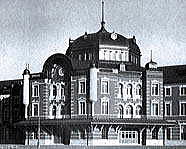
At the time of the foundation
(1914-1945)
Dome-shaped roof
Three storied above ground
Steel-framed and brick structure
|
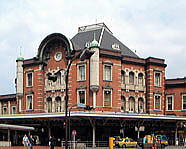
Before restoration(1947-2007)
Hipped roof
Two soried above ground
(partially three-storied)
Steel-framed and brick structure
|
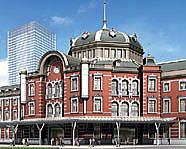
After restoration(2012~)
Dome-shaped roof
Three storied above ground
and two below
Steel-framed and brick structure
Quake-absorbing structure
|
[Reference] http://www.kajima.co.jp/tech/tokyo_station/righting/index-j.html

The outline of restoration work |
|
In this restoration work, the first and second basement were newly added on and also the
quake-absorbing equipments were set.
I took a lot of photos of Tokyo Station, while admiring the view of it.
I'd like to introduce a part of them to you.
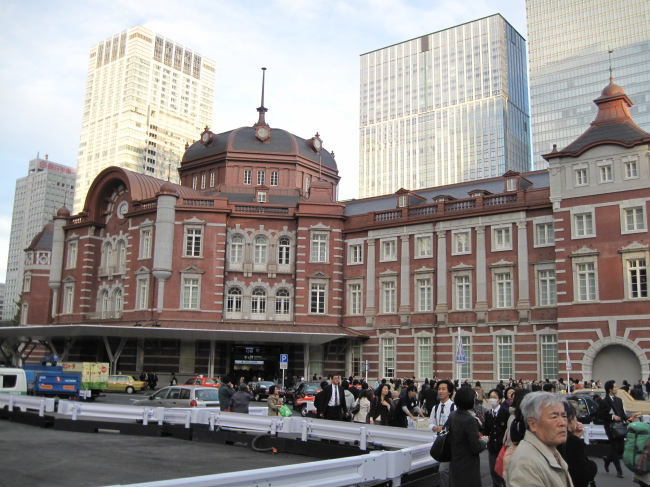
The view of north gate of the Murunouchi side of Tokyo Station |
|
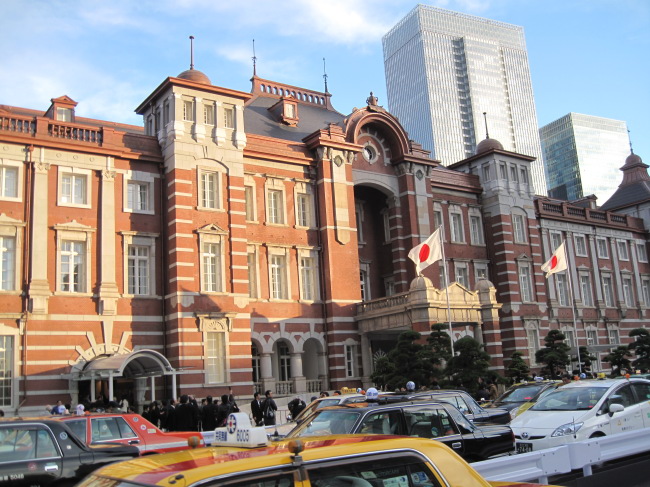
The view of central gate of the Murunouchi side of Tokyo Station |
|
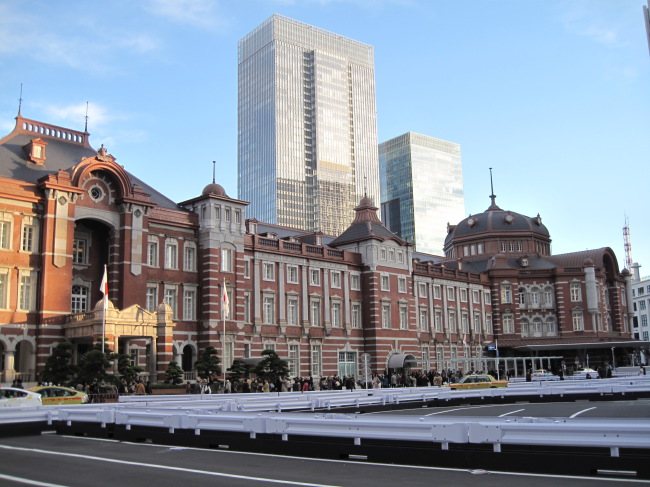
The view of south gate of the Murunouchi side of Tokyo Station |
|
How is the view of the restored station ?
It is really beautiful, isn't it ?
Then, I got into a building with the north dome to look at the ceiling.
The wall of the two-storied dome is decorated with reliefs of animal symbols.
The ceiling is octagonal.
Therefore, four signs of the Chinese zodiac out of twelve ones are omitted.
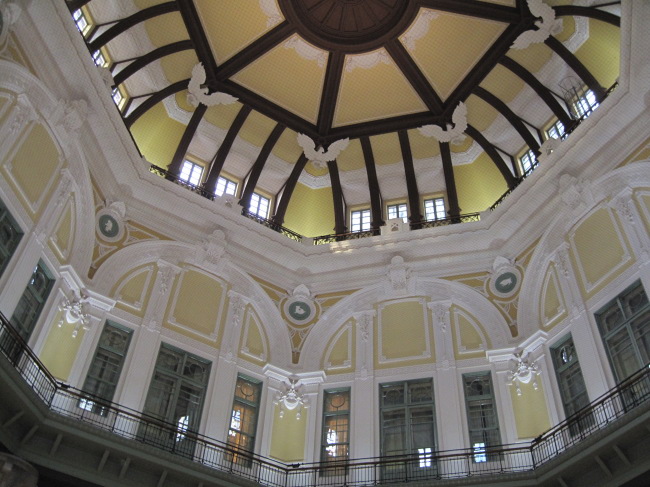
The decoration around the ceiling of the north dome |
|
Not only the appearance of the station but also the decoration inside
the dome is great !
Twilight is drawing on Tokyo Station.
As I fulfilled my heart's desire, I hastened toward the platform of JR
Tokaido Line to avoid the
evening rush hour.
<The date of the taking of the photos ; Nov.15,2012 >
[Note] Ordinarily ;いつもなら, 通常, see the sights of ~;~を見物する
restored;復元された,修復された,restoration work ;復元工事
red-brick;赤レンガの,look hard at ~;まじまじと~を見る、 hipped roof、 寄棟屋根
steel-framed ;鉄骨の、 quake-absorbing structure ;免震構造, interior decoration ;内装
admire the view of ~;~の景色に見惚れる, ceiling;天井、 relief ;レリ-フ(浮き彫り)
animal symbols;干支, octagonal ;8 角形、 twelve signs of the Chinese zodiac ;十二支
twilight draw on ;夕闇が迫る, hasten toward ~;~の方へ急いで行く
fulfill one's heart's desire ;念願がかなう
Japanese Diary / No.497-2012.11.23 / Diary / No.497-2012.11.23 /
“「はとバス」で浅草観音と東京スカイツリ-を訪ねる(3/3) ”
It was about 0:30 PM when we got to bus parking area near Kaminarimon
of Senso-ji Temple.
The Sky Tree that can be seen at Kaminarimon intersection is really wonderful,
isn't it?
We got to tempura restaurant “Aoimarushin” in only 3 minutes on foot.
After a glass of water, we had a Tempura Teishoku for lunch enjoying conversation.
We walked around Nakamise Dori and then Senso-ji Temple after about 40
minutes lunch break.
It is the first time for me to visit Kannondo hall of Senso-ji Temple and
Nakamise Dori since a junior
high school trip.
I had lived in the Tokyo metropolitan area for 45 years.
But unexpectedly, I saw that the lighthouse does not shine on its base.
This is the mountain gate, “Kaminarimon” of Senso-ji Temple.
It is officially called Furaijinmon.
Fujin, literally the god of wind, is located on the right when facing the
gate, while Raijin, literally
the god of thunder, is located on the left.
In the center of the Kaminarimon, under the gate, hangs a giant chochin
that weigh 670 Kilograms.
When we pass through the Kaminarimon, we get to Nakamisei.
Even though today is a weekday, it is very crowded with visitors as you
can see.
The Nakamise is a shopping street which last for more than 250 years from Edo Period.
Nakamise Dori with 250 meters in length leading from Kaminarimon to Hozomon of Senso-ji
Temple is lined with a variety of small shops selling goods ranging from toys, sweets and traditional
crafts to suveniors.
Kaminariokoshi, one of Japanese sweets, was selled.
Ah, memories!
They don't sell any expensive goods.
Only forign visitors might have an interest in goods like chochin, Japanese
fan, Japanese umbrella
and Happi coat.
I often saw them in those shops.
Going ahead through the Nakamise Dori with an old down town atomosphere,
we can see Hozomon
at the front of it.
Hozomon is a two-storey gate with a hip-and-gable roof structure.
It is a reinforced concrete structure and obviously seems to be modern
architecture.
As Kongo Rikishi were enshrined at least on either side of the gate, it must once have been
called Niomon Gate.
In the center of the gate, under the gate, hangs a huge vermilion-lacquered
chochin on which was
written “Kobuna-cho” in bold strokes.
It weighs 400 Kilograms.
It' said that the chochin was donated by some volunteers in Nihonbashi
Kobune-cho,Chuo-ku, Tokyo.
The initial trigger for the donation was that behaver of the temple who
were merchants of the fish
market in the town dedicated a chochin in the early Edo Period.
The custom have been kept up even until now.
Going ahead again, we can see the main hall (Kannon-do) of Senso-ji Temple
at the front.
That is also a modern architecture with reinforced concrete structure.
I think it can't be helped because the temple was reconstructed after burning
down during the war.
Then we enjoyed the relaxing walk around Shitamachi area near Senso-ji
Temple.
One of the tour themes was Tokyo Sky Tree, so we necessarily kept our eys
glued to it.
I'd like to introduce you to some photos of the Sky Tree from around Senso-ji
Temple.
I've visited many temples in Kamakura, Nara and Kyoto in the name of “Old
Temples Pligrimage”.
I hesitate whether to put Senso-ji Temple into the same category as Old
Temple.
We've come to end of this tour.
Commemorative photos with Tokyo Sky Tree for a background were taken at
the parking area
of Senso-ji Temple.
After that, we left Senso-ji Temple for Tokyo station.
<The date of the taking of the photos ; Nov.15,2012 >
To be continued  Weekly Topics / No.181-Dec.XX.2012 / Weekly Topics / No.181-Dec.XX.2012 /
“Hato Bus Seightseeing Tour of Tokyo Sky Tree and Senso-ji Temple(3/3)”
(Being released soon. Don't miss it!)
[Note] Tempura Teishoku ; 天ぷら定食,Nakamise Dori ;仲見世通り
school trip ;修学旅行,unexpectedly ;意外にも
the lighthouse does not shine on its base ;灯台下暗し、 Furaijinmon ;風雷神門
on the right when facing ~;~に向かって右側に, literally ;文字通り
chochin;提灯, weigh ~ Kilograms; 重さが~Kg である、 Hozomon;宝蔵門
be lined with ~ ;~がずらりと並ぶ、 ~ ranging from A to B;A からB までの~
Ah, memories!;懐かしいですね、 Japanese fan;扇子,Happi coat;ハッピ(法被)
two-storey;二階建ての、 hip-and-gable roof structure;入母屋造り, gable roof;切屋根妻
reinforced concrete structure;鉄筋コンクリ-ト造り,Kongo Rikishi;金剛力士像
on either side of ~;~の左右に, enshrine;安置する
vermilion-lacquered;朱塗りの,in bold strokes;筆太に,donate;寄付(進)する
the initial trigger for ~;~の最初のきっかけ, behaver;信者、 fish market;魚河岸,魚市場
dedicate;奉げる,奉納する、keep up ~;~し続ける, 存続させる, hesitate;ちゅうちょする
Shitamachi;下町、burn down;焼失する、 it can't be helped;それは已むを得ない, それは仕方がない
keep one's eys glued to ~;~に目を奪われる,~にくぎ付けになる
take a photo with ~ for a background;~を背景に写真を撮る
Japanese Diary / No.496-2012.11.22 / Diary / No.496-2012.11.22 /
“ 「はとバス」で浅草観音と東京スカイツリ-を訪ねる(2/3) ”
I attended a reunion with people who belonged to the same training group
when I had the
training session for newly-appointed senior stuff members in my career.
We call our reunion “M872 Society”.
The socity holds an event once a year.
This year, its theme is as the topic mentioned above.
Here is today's schedule.
■ 9:10 AM ; Departing from the South Marunouchi exit of Tokyo Station by
Hato Bus.
● Looking around Tokyo Solamachi (50 minutes)
● Enjoying the great view from the first observation deck 350 meters above
the ground (80 minutes)
● Lunch at tempura restaurant Aoimarushin in Asakusa (40 minutes)
● Looking around the Nakamise Shopping Street and Senso-ji Temple
(50 minutes)
■ 3:30 PM ; Arriving at Tokyo Station
I haven't experienced commuting rush hours for years.
I took a jam-packed Tokaido Line train to Tokyo station.
It seemed to me that rush-hour congestion has been reduced a little bit
compared to that of before
my retirement.
 The South Marunouchi exit of Tokyo Station in the morning The South Marunouchi exit of Tokyo Station in the morning |
|
I can see many familiar faces at Hato Bus terminal.
I was very surprised to see their filled buses leaving one after another.
The number of our tour members is a total of 22 people including some members with their wives.
We left Tokyo bus terminal at 9:10 AM for Tokyo Sky Tree in Oshiage of
Sumida Ward with other
visitors.
The bus tour guide informed us of today's time schedule, the places we will visit and meeting
place / time after visiting each place in the bus.
Anyway, we have to be careful not to get lost because we take a group action.
By the time the bus crossed Ryogoku Bridge over the Sumida River after
passing through
Nihonbashi, we came in sjght of Tokyo Sky Tree.
Please click the picture to see a full-size version
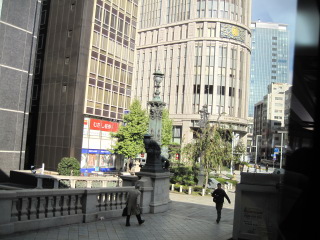
Passing through Nihonbashi Bridge |
|
|
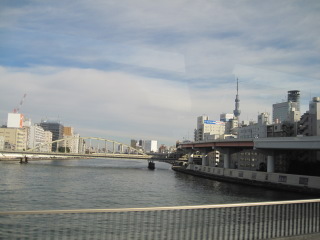
Crossing Ryogoku Bridge over the Sumida River |
|
First we received the explanation about Tokyo Sky Tree by the bus tour
guide.
According to her, the outline is as follow.
It was opened on Mat 22, 2012.
The 634-meter Tokyo Sky Tree is the world's highest free-standing broadcasting
tower.
The tower was originally specified even lower in the original project.
After that, it was decided that it has to be constructed so that it might
as well be the highest
in the world.
And so it was changed to hights of 634 meters to reflect the fact that
Tokyo was once called
“Musashi no Kuni”.
One of the main role of the tower is to transmit terrestrial digital broadcasts
and so on.
Since the signals are transmitted from 600-meter class of tall tower, one
seg users can expect that
they will be able to watch TV on their cell-phones in more areaas.
The tower's operator is Tobu Tower Sky Tree Co., Ltd, whose largest shareholder is Tobu Railway
Co., Ltd.
The construction cost was about 40 billion yen.
They plan to earn revenue from rent for the tower from TV broadcasters
and admission fee for visitors.
About 30 minutea after leaving Tokyo Station, we arrived at bus parking area near Tokyo Sky Tree
Town.
Tokyo Sky Tree Town is a huge complex which consists of a commerce facility
“Tokyo Solamachi”,
offices, an aquarium and a planetarium including Tokyo Sky Tree.
We walked to Tokyo Solamachi as if we were hicks.
When we are so close to Sky Tree, we can't see it without looking out because
it is too high.
Please click the picture to see a full-size version
We got to the entrance of Tokyo Solamachi under her guidance.
Each of us looked around Tokyo Solamachi for about 50 minutes as we like.
Tokyo solamachi is a large-scale commercial facility which include a total
of 312 shops and
restaurants stretching east yo west.
They are located on the second and third floor of Tokyo Sky Tree Town around
the tower.
Here are a photo that conveys atmosphere of Solamachi shopping district and two photos of
typical shop.
Please click the picture to see a full-size version
We got together on the 4th floor which are elevator (called Tembo Shuttle)
lobbies to have a view
from the first observation deck of the Sky Tree.
We got to an elevator lobby after baggage inspection.
There is a picture with motif of one of four seaons on each wall inside
4 elevators.
Those tembo shuttles are Japan's fastest elevators with a speed of 600 meters per minute.
They carry a maximum capacity of 40 visitors to the first observation deck
at 350 meters above
the ground in about 50 seconds.
It was very crowded as you can see.
The fine weather enabled us to enjoy the best panoramic view in Japan.
I'd like to introduce you to some of their views.
Please click the picture to see a full-size version
|
|
|
|
|
|
| The view from the first observation deck in Tokyo Sky Tree |
I gave up on the idea of going to 2-nd observation deck (called Tembo
Galleria / 450 meters above the ground) from the Tembo Deck.
It's because we have to wait in line for 30 minutes.
It has already been half a year since the complex opened this May.
However, the number of visitors is still tremendous.
If we purchase day ticket for Tokyo Sky Tree observatory, we have to wait
for about 2 hours.
The number of visitors from the opening day to the end of Semtember was
21
million and total prospective number of visitors will be expected to be
44
million, I heard.
Tobu Railway must become profitable.
Additionally, I visited the company's Web site to see the consolidated
business performance
for the half-year period in the fiscal year ended Mar 2013.
The net profit was about 115 million yen.
This is a 75 % profit increase on a year to year comparison.
It is said that 60 percent is due to the Sky Tree effect.
I thought so.
It's also said that the Sky Tree has a positive effect on economy in the
related area.
After visiting the Sky Tree, we headed to Asakusa's Kaminarimon to have
a lunch at tempura
restaurant “Aoimarushin”.
<The date of the taking of the photos ; Nov.15,2012 >
To be continued  Weekly Topics / No.180-Nov.XX.2012 / Weekly Topics / No.180-Nov.XX.2012 /
“Hato Bus Seightseeing Tour of Tokyo Sky Tree and Senso-ji Temple(2/3)”
[Note] Senso-ji Temple ; 浅草寺, training session; 研修
newly-appointed senior stuff members; 新任幹部社員
in one's career; 現役時代に, the topic mentioned above; 標記, 掲題
commuting rush hours; 通勤ラッシュ, jam-packed train; 満員電車
rush-hour congestion; ラッシュアワ-の混雑, filled bus ; 定員一杯のバス
get lost; 迷い子になる,take a group action; 団体行動をとる
by the time ~ ;~の頃には, come in sight of ~;~が見えてくる
receive the explanation about ~ ; ~の説明を受ける, free-standing; 自立式の
might as well ~;~する方がましだ, Musashi no Kuni; 武蔵の国
terrestrial digital broadcasts; 地上デジタル放送、 one seg user; ワンセグ利用者
largest shareholde; 筆頭株主、earn revenue from ~;~から収益を得る, complex; 複合施設
hick; (軽蔑的に)田舎者, おのぼりさん, conveys atmosphere; 雰囲気を伝える
got together;集合する, tembo shuttle; 展望シャトル、 elevator lobby; エレベ-タ-ホ-ル(乗り場)
observation deck; 展望デッキ、 give up on ~;~をあきらめる,Tembo Galleria; 天望回廊
tremendous;(大きさや程度が) ものすごい, とてつもなく大きい、 observatory; 展望台
day ticket;当日券, prospective number; 見込み数
consolidated business performance ;連結業績, consolidated ;統合された
half-year period ;中間期, in the fiscal year ended Mar 2013; 2013/03 月期
net profit;純利益, 75 % profit increase ;75 % の増益
on a year to year comparison; 前年同期比で, I thought so; やっぱりね
Japanese Diary / No.495-2012.11.21 / Diary / No.495-2012.11.21 /
“「はとバス」で浅草観音と東京スカイツリ-を訪ねる(1/3) ”
 TOPペ-ジへ戻る TOPペ-ジへ戻る
|
|